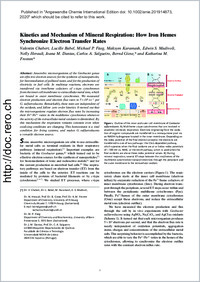Kinetics and mechanism of mineral respiration: how iron hemes synchronize electron transfer rates
- Chabert, Valentin Department of Chemistry
- Babel, Lucille Department of Chemistry
- Füeg, Michael P. Department of Chemistry and Biochemistry
- Karamash, Maksym Department of Chemistry
- Madivoli, Edwin S. Department of Chemistry
- Herault, Nelly Department of Chemistry
- Dantas, Joana M. UCIBIO-Requimte
- Salgueiro, Carlos A. UCIBIO-Requimte
- Giese, Bernd Department of Chemistry
- Fromm, Katharina M. Department of Chemistry
-
09.12.2019
Published in:
- Angewandte Chemie International Edition. - 2020, vol. 59, no. 30, p. 12331-12336
English
Anaerobic microorganisms of the Geobacter genus are effective electron sources for the synthesis of nanoparticles, for bioremediation of polluted water, and for the production of electricity in fuel cells. In multistep reactions, electrons are transferred via iron/heme cofactors of c‐type cytochromes from the inner cell membrane to extracellular metal ions, which are bound to outer membrane cytochromes. We measured electron production and electron flux rates to 5×105 e s−1 per G. sulfurreducens. Remarkably, these rates are independent of the oxidants, and follow zero order kinetics. It turned out that the microorganisms regulate electron flux rates by increasing their Fe2+/Fe3+ ratios in the multiheme cytochromes whenever the activity of the extracellular metal oxidants is diminished. By this mechanism the respiration remains constant even when oxidizing conditions are changing. This homeostasis is a vital condition for living systems, and makes G. sulfurreducens a versatile electron source.
- Faculty
- Faculté des sciences et de médecine
- Department
- Département de Chimie
- Language
-
- English
- Classification
- Chemistry
- License
-
License undefined
- Identifiers
-
- RERO DOC 328181
- DOI 10.1002/anie.201914873
- Persistent URL
- https://folia.unifr.ch/unifr/documents/308585
Other files
Statistics
Document views: 115
File downloads:
- pdf: 282
- Supplementary material: 181

